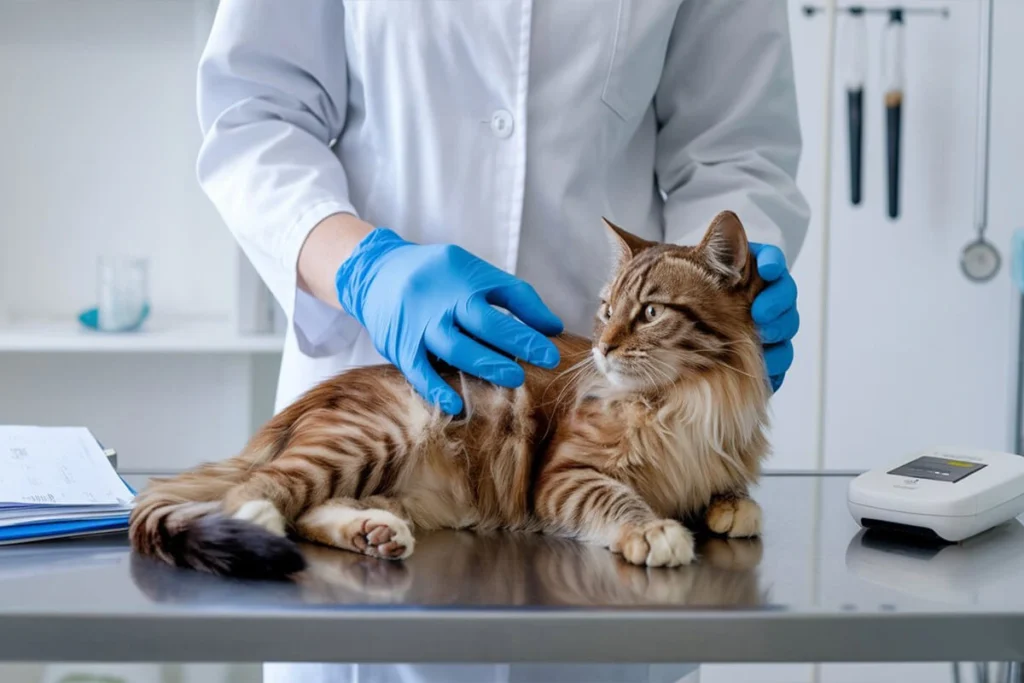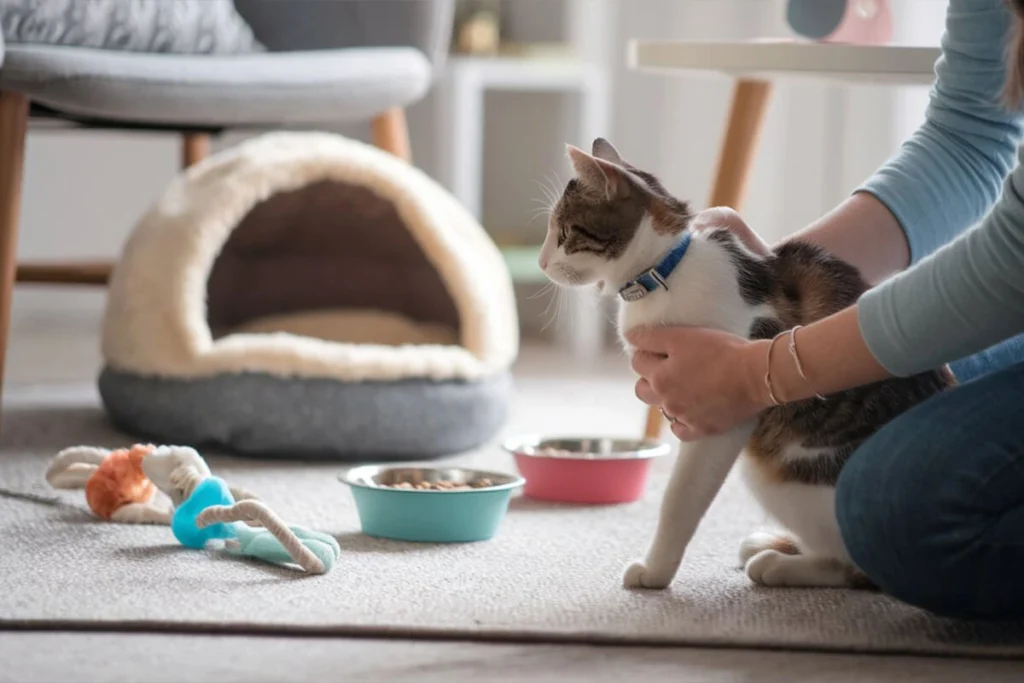Understanding how to rehome a cat is essential when life circumstances change, or your feline companion needs a different environment. Rehoming a cat is not just about finding them a new home—it’s about ensuring their well-being throughout the transition. This process requires careful thought, patience, and love to secure a safe, happy, and stable future for your pet.
Many cat owners feel guilt and uncertainty when facing the reality of rehoming. However, when done responsibly, rehoming a cat can provide them with a better quality of life in a home that meets their needs. Instead of making a rushed decision, take the time to explore how to rehome a cat in a way that prioritizes their emotional and physical well-being. Every step—from preparing your cat for the move to carefully selecting a trustworthy adopter—plays a crucial role in ensuring a smooth transition.
This guide will walk you through how to rehome a cat responsibly. You’ll learn about safe rehoming alternatives, important steps in the adoption screening process, and practical tips to help your cat adjust to their new home. By following these best practices, you can give your feline companion the best possible future while feeling confident that they will be loved and cared for in their new home.
Understanding When and Why Rehoming a Cat is Necessary
Common Reasons for Rehoming a Cat
Many cat owners face difficult situations that make rehoming a cat necessary. Life changes, financial struggles, and unexpected challenges can create an environment where keeping a pet feels impossible. Some of the most common reasons include:
- Allergies or Health Issues – A family member may develop severe cat allergies, making it hard to keep the cat without risking their well-being. In some cases, respiratory conditions like asthma worsen in a household with pet dander.
- Moving to a New Home – Some landlords do not allow pets, and finding a cat-friendly rental can be difficult. Military deployments, job relocations, or personal circumstances may also force an owner to move somewhere unsuitable for their cat.
- Financial Hardships – Veterinary care, high-quality food, and pet supplies can become overwhelming during tough financial times. If an owner can no longer afford proper care, rehoming a cat might be the best way to ensure their well-being.
- Behavioral Issues – Some cats develop habits like excessive aggression, litter box problems, or destructive scratching. If training efforts fail and stress builds in the home, an owner may consider rehoming a cat to a household better equipped to manage their needs.
- Changes in Family Dynamics – A new baby, a divorce, or a blending of households with other pets can create a stressful situation for a cat. In some cases, the cat may not adjust well, making rehoming a cat a necessary step for both the pet and the family.
Although rehoming a cat can feel heartbreaking, understanding the reasons behind it helps owners make the best decision for their pet’s future.
Exploring Alternatives Before Deciding to Rehome
Before taking the final step to rehome a cat, owners should explore possible solutions that could allow them to keep their feline companion. Sometimes, a small adjustment or extra support can resolve the issue.
- Seek Training and Behavioral Support – If the decision to rehome a cat comes from behavioral problems, owners should first work with a feline behaviorist or trainer. Simple changes, like using pheromone diffusers, adjusting the feeding schedule, or adding more playtime, can resolve many issues.
- Find Temporary Care Options – If financial hardship, illness, or short-term travel makes cat care difficult, owners can look into temporary foster care instead of rehoming a cat permanently. Some animal shelters and rescue groups offer temporary placement for cats until owners regain stability.
- Modify the Home Environment – Cats need safe and comfortable spaces to thrive. If a cat seems stressed, adding vertical spaces like cat trees, providing more litter boxes, or creating quiet hiding spots can reduce anxiety and improve behavior.
- Request Assistance from Friends or Family – Before looking for an adopter, owners should check if a trusted friend or relative can help with care. A familiar face can make the transition easier for the cat and allow the owner to stay connected.
Taking the time to consider alternatives ensures that rehoming a cat remains a last resort rather than an immediate solution.
Consulting a Veterinarian or Pet Expert for Advice
If an owner feels unsure about rehoming a cat, a veterinarian or pet expert can provide guidance. Vets understand feline behavior, health issues, and environmental stressors, so they can assess whether a cat truly needs rehoming or if there are ways to keep them in the home.
- Health Checkups and Medical Solutions – Some behavioral issues stem from medical problems. A vet visit can help rule out conditions like urinary tract infections (which cause litter box problems) or anxiety disorders that might explain sudden aggression.
- Dietary and Environmental Changes – A pet expert can recommend dietary adjustments or enrichment strategies to improve a cat’s overall well-being. For example, interactive feeding, calming supplements, or a structured routine can sometimes resolve the challenges that make an owner consider rehoming a cat.
- Rehoming Guidance and Safe Practices – If rehoming a cat remains the best choice, a vet or animal shelter professional can suggest ethical and safe rehoming options. They can connect owners with reputable adoption agencies, provide screening advice, and ensure the transition happens with minimal stress.
Seeking expert advice can help an owner make a well-informed decision while prioritizing their cat’s happiness and health.
Preparing Your Cat for Rehoming
Ensuring Vaccinations and Microchipping Are Up to Date
Before rehoming a cat, owners must ensure their pet is healthy, protected, and ready for a smooth transition. Vaccinations and microchipping play a crucial role in keeping a cat safe, especially when moving to a new environment.

- Update Core Vaccinations – A cat should be fully vaccinated before rehoming. Core vaccines, including those for rabies, feline calicivirus, feline herpesvirus, and feline panleukopenia, help protect them from life-threatening diseases. If a cat isn’t up to date on shots, scheduling a vet appointment before rehoming is essential.
- Microchip for Safety and Identification – Microchipping increases the chances of a lost cat being returned to its new owner. If a cat already has a microchip, the owner should update the contact information with the registry before transferring ownership. If the cat isn’t chipped, adding one ensures their safety, especially during the transition to a new home.
- Preventative Care and Parasite Control – A new owner should not inherit unexpected health concerns. The current owner should ensure the cat is free from fleas, ticks, and worms by administering proper preventative treatments before rehoming. Providing documentation of these treatments makes the transition easier for both the cat and the new family.
Taking these steps guarantees that a cat enters their new home healthy, protected, and ready to thrive.
How to Rehome a Cat by Preparing Essential Records for a Smooth Transition
Understanding how to rehome a cat responsibly means ensuring the new owner has all the necessary information to provide proper care. A detailed record of the cat’s medical history, personality, and daily needs helps create a seamless transition, reducing stress for both the cat and their new family.
- Compile Medical History – A crucial part of how to rehome a cat is making sure the new owner has access to the cat’s medical records. Gather documents related to vaccinations, past illnesses, medications, and recent vet visits. If the cat has ongoing health concerns, providing a written care plan helps maintain consistency in their treatment.
- List Dietary Preferences and Feeding Schedule – A cat’s diet plays a major role in their health and comfort. Clearly outlining the brand of food they eat, portion sizes, feeding times, and any dietary restrictions ensures they don’t experience digestive issues after rehoming. Consistency in diet helps the cat adjust more quickly to their new home.
- Describe Personality, Behavior, and Routine – When figuring out how to rehome a cat successfully, it’s important to provide the adopter with insights into the cat’s habits and temperament. Writing a short document about whether the cat is independent or affectionate, how they react to strangers, and what toys or activities they enjoy helps the new owner bond with them more easily.
- Include Important Contact Information – Providing the name and contact details of the cat’s veterinarian allows the new owner to follow up on medical care if necessary. If the cat has specific health needs, direct communication with their previous vet can be extremely helpful.
Taking the time to prepare these essential records ensures rehoming a cat leads to a smooth transition. A well-informed new owner can offer the cat a stable, loving home where they can thrive.
Helping Your Cat Adjust to Changes Before Transitioning to a New Home
Cats thrive on routine and stability, so sudden changes can cause stress and anxiety. Helping a cat adjust before rehoming makes the transition smoother and reduces the risk of behavioral issues in their new home.
- Gradually Introduce Changes – If possible, the owner should introduce small changes before rehoming a cat. This might include adjusting feeding times, using the new owner’s preferred food, or gradually reducing direct attention to encourage independence. These adjustments help the cat adapt more easily.
- Provide Comfort and Familiar Items – A cat finds security in familiar scents and objects. Sending them to their new home with their favorite blanket, bed, or toys can provide comfort and reduce anxiety. Including a piece of fabric with the old owner’s scent can also help them feel reassured in the new environment.
- Minimize Stress and Maintain Routine – Keeping the cat’s routine as consistent as possible before rehoming prevents unnecessary stress. Feeding, playtime, and litter box habits should remain unchanged leading up to the transition. Avoid loud noises, unnecessary travel, or sudden disruptions that might make the cat feel uneasy.
- Introduce a Carrier in Advance – Many cats dislike travel carriers, so getting them comfortable with one before rehoming is important. Leaving the carrier open in the home with treats or bedding inside can help the cat associate it with safety rather than fear, making transportation to their new home much easier.
Taking these steps ensures that rehoming a cat happens with as little stress as possible, allowing them to feel secure and confident in their new home.
Finding the Right Home: Responsible Rehoming Methods
Using Reputable Pet Adoption Agencies and Cat Rescue Organizations
Rehoming a cat through trusted organizations ensures they end up in a safe and loving home. Many pet adoption agencies and cat rescue organizations specialize in matching cats with responsible owners, making the process smoother and more secure.

- Work with Local Animal Shelters and Rescues – Many shelters and rescue groups offer rehoming programs that help place cats in pre-screened homes. They handle the adoption screening process and ensure potential adopters meet the necessary qualifications.
- Consider Foster-Based Rescue Groups – Some cat rescue organizations rely on foster homes instead of shelters. This allows a cat to transition to a temporary home while waiting for a permanent adopter. Foster-based rescues often provide updates on the cat’s well-being, ensuring they go to the best possible home.
- Check for No-Kill Shelters – No-kill shelters prioritize finding homes for cats rather than euthanizing them due to space limitations. If surrendering a cat to a shelter becomes the only option, choosing a no-kill facility increases the chances of a successful adoption.
- Verify the Organization’s Reputation – Before working with an agency or rescue, owners should research reviews, policies, and adoption procedures. Reputable organizations will have a structured process, including applications, interviews, and home visits to ensure responsible placements.
Using professional resources prevents the risk of placing a cat in an unsafe or unsuitable home while giving them a higher chance of a stable future.
Screening Potential Adopters
Finding a responsible adopter is one of the most important steps in rehoming a cat. Instead of handing a pet over to the first person who expresses interest, owners should take the time to evaluate potential adopters and ensure they can provide a loving home.
- Ask Detailed Questions – Owners should conduct a short interview with potential adopters to learn about their experience with cats, their living situation, and their ability to provide long-term care. Important questions include:
- Have you owned a cat before?
- Do you have other pets, and how do they interact with cats?
- Do you rent or own your home? If renting, does your landlord allow pets?
- Are you financially prepared for vet care, food, and emergencies?
- Request a Veterinary Reference – Asking for a vet reference helps verify that the adopter has experience with responsible pet ownership. If the person has never owned a pet, ensuring they understand basic care requirements is crucial.
- Conduct a Home Visit or Virtual Tour – If possible, visiting the potential adopter’s home helps confirm that it’s a safe environment for the cat. Owners should check for hazards, proper living space, and a secure area where the cat can feel comfortable.
- Observe the Adopter’s Interaction with the Cat – Meeting the adopter in person and watching how they interact with the cat can reveal a lot about their suitability. A gentle and patient approach indicates a good match, while rough handling or hesitation may be red flags.
Screening adopters ensures that a cat goes to a responsible home, reducing the risk of future abandonment or neglect.
Avoiding Unsafe Methods Like Giving a Cat Away for Free Online
Rehoming a cat responsibly means avoiding risky methods that could put them in danger. Giving a cat away for free online may attract people with bad intentions, including neglectful owners, animal abusers, or those looking to exploit pets for breeding or resale.
- Avoid Posting “Free to a Good Home” Ads – Offering a cat for free on classified websites or social media groups can attract the wrong people. Some individuals take free cats for unethical purposes, such as using them as bait animals or selling them for profit. Charging a reasonable rehoming fee helps filter out irresponsible adopters.
- Be Wary of Quick Adoptions – If an adopter seems overly eager to take a cat without asking questions or showing concern for their needs, this is a red flag. Responsible adopters will ask about the cat’s personality, health, and care requirements before making a decision.
- Meet in a Safe, Controlled Environment – Instead of handing a cat over in a public parking lot or an unfamiliar location, owners should arrange meetings in a controlled space, such as a vet’s office or their home. This allows for better assessment of the adopter.
- Use Trusted Rehoming Platforms – Websites like Rehome by Adopt-a-Pet or Petfinder provide secure platforms for rehoming a cat. These services require adopters to go through an application process, reducing the risk of a cat ending up in the wrong hands.
Avoiding unsafe rehoming methods protects a cat from potential harm and ensures they find a secure, loving home where they will be well cared for.
The Safe Cat Adoption Process: Ensuring a Smooth Transition
How to Rehome a Cat by Preparing the New Owner for a Smooth Transition
Understanding how to rehome a cat responsibly means more than just finding a new home—it also involves making sure the new owner understands the cat’s personality, daily routines, and care needs.

- Provide a Detailed Care Guide – When learning how to rehome a cat, one of the most important steps is giving the adopter a written guide about the cat’s needs. Include information on their feeding schedule, preferred food brands, litter box habits, and favorite activities.
- Explain Behavioral Traits and Preferences – Every cat has a unique personality, so when rehoming a cat, it’s crucial to inform the new owner about their habits and preferences. Some cats enjoy affection and lap time, while others prefer independence.
- Discuss Health and Veterinary Care – A responsible approach to how to rehome a cat includes sharing their medical history. Providing details about recent vaccinations, known medical conditions, and any necessary medications ensures the cat continues to receive proper care. If the cat has a preferred veterinarian, passing along this information can help the transition go smoothly.
- Encourage Patience and a Gentle Approach – Moving to a new home is a big change for any cat. The new owner should understand that adjustment takes time and that the cat may hide, act shy, or take a few days to warm up.
By taking these steps, you can help your feline companion settle into their new home with confidence and comfort.understand these details ensures that the cat receives the love and care they need in their new home.
Gradually Introducing the Cat to Their New Environment
A new home can feel overwhelming for a cat, so a slow and gentle introduction helps them adjust comfortably. Rather than letting them roam freely right away, the new owner should follow a gradual process to reduce stress.
- Start with a Small, Safe Space – Instead of giving the cat access to the entire house immediately, the new owner should start with one quiet room. This space should include their litter box, food, water, and a hiding spot. Allowing the cat to explore at their own pace helps them feel secure.
- Let the Cat Set the Pace – Some cats adjust quickly, while others need more time. The new owner should avoid forcing interactions and instead allow the cat to come to them when they feel comfortable. Speaking softly and using treats or toys can encourage trust.
- Introduce Other Pets Slowly – If the new home has other animals, introductions should be done gradually. A slow and supervised process—such as keeping the cat separated at first and allowing scent exchanges through blankets or doors—prevents stress and potential conflicts.
- Maintain a Consistent Routine – Sticking to a regular feeding schedule and playtime routine helps the cat feel more at ease. The new owner should try to keep mealtimes and sleeping areas consistent to provide a sense of familiarity.
Taking a patient approach ensures that the cat feels safe and comfortable as they explore their new surroundings.
Providing the New Owner with Familiar Items
When rehoming a cat, familiar scents and objects can provide comfort and make the transition easier. Cats rely on scent to feel secure, so bringing familiar items into their new environment can help reduce anxiety.
- Send the Cat’s Favorite Blanket or Bed – A blanket, bed, or piece of fabric with the cat’s scent gives them a sense of familiarity in their new home. This can make the transition less overwhelming by providing a comforting smell from their previous home.
- Include Favorite Toys and Scratching Posts – If the cat has a favorite toy, scratching post, or play tunnel, sending these items along helps them feel at ease. Playing with familiar objects encourages the cat to engage with their new environment without feeling lost.
- Provide Used Litter or a Litter Box with Familiar Scent – Using a small amount of the cat’s old litter in their new box helps them recognize their designated bathroom area. This can prevent accidents and ease the transition.
- Offer a Clothing Item with the Previous Owner’s Scent – If possible, providing a worn T-shirt or small item with the previous owner’s scent can be comforting for the cat, especially in the first few days of adjustment.
These small but meaningful details help the cat settle into their new home more easily, reducing stress and making the transition smoother for both the pet and the new owner.
Supporting Your Cat After Rehoming
Following Up with the New Owner to Ensure a Successful Transition
Rehoming a cat doesn’t end once the cat moves to a new home. A responsible rehoming process includes checking in with the new owner to ensure the cat is adjusting well and receiving the care they need. Following up shows that the cat’s well-being remains a priority and helps prevent any potential issues from escalating.

- Check In Within the First Few Days and Weeks – Rehoming a cat involves an adjustment period, so a follow-up within the first few days allows the new owner to ask questions and share initial updates. A second follow-up after a few weeks ensures that the cat is settling in comfortably.
- Ask About the Cat’s Eating Habits, Litter Box Use, and Behavior – When rehoming a cat, one of the biggest concerns is how they adjust to their new environment. Checking on whether the cat is eating well, using the litter box consistently, and showing signs of relaxation helps determine their progress.
- Encourage the New Owner to Reach Out for Support – Many adopters may feel unsure about reaching out with questions, but rehoming a cat successfully means ensuring they have all the guidance they need. Letting them know they can ask about feeding, behavior, or adjustment challenges makes the transition smoother.
- Offer Support Without Overstepping – While follow-ups are important, rehoming a cat should also allow the new owner to build their own bond with the pet. Checking in should feel supportive, not intrusive, and should focus on making sure the cat is safe and happy.
Following up reinforces that rehoming a cat responsibly means ensuring they thrive in their new home, not just handing them off.
How to Rehome a Cat by Helping Them Adjust to Their New Home
Successfully understanding how to rehome a cat involves more than just handing them over to a new owner—it requires ensuring they feel safe, comfortable, and secure in their new environment.
- Encourage a Slow and Gentle Introduction to Their New Home – When figuring out how to rehome a cat properly, it’s important to prepare the new owner for the adjustment period. Cats may feel overwhelmed at first, so instead of giving them immediate access to the entire house, setting up a quiet, designated space allows them to feel secure before gradually exploring their surroundings.
- Reassure the Adopter That Hiding and Shyness Are Normal – One of the most common challenges in how to rehome a cat is managing their initial behavior. Many cats hide or act withdrawn in the first few days as they process the change. Letting the new owner know this is completely normal and temporary can help them remain patient and avoid unnecessary stress.
- Suggest Bonding Techniques to Build Trust – Ensuring a smooth transition when rehoming a cat means helping them form a connection with their new family. Encouraging gentle interactions, soft-spoken communication, and using treats or favorite toys can make the cat feel more comfortable and help establish trust.
- Emphasize the Importance of Routine and Stability – Cats thrive on routine, and sudden changes can make them anxious. Advising the new owner to stick to a consistent feeding schedule, provide a designated sleeping area, and avoid sudden disruptions can help the cat settle in faster.
By guiding the new owner through these steps, you can ensure that rehoming a cat leads to a successful, stress-free transition where the cat feels loved, safe, and truly at home.
Knowing When to Step Back and Let the New Family Bond with the Cat
When rehoming a cat, it’s natural to feel attached and want updates, but it’s equally important to know when to step back and allow the new family to establish their own connection with the pet. Giving space allows the cat to settle in without unnecessary disruptions.
- Trust That the New Owner Will Provide a Loving Home – If the rehoming process was done responsibly, there is no reason to worry. Trusting that the cat is in safe hands allows the new family to bond without interference.
- Avoid Excessive Check-Ins or Unannounced Visits – While following up is helpful, constantly checking in can make the new owner feel pressured. Rehoming a cat means allowing the pet to move forward with their new family without feeling like they are being watched.
- Accept That the Cat Will Form New Attachments – Successfully rehoming a cat means understanding that they will eventually bond with their new owner. While it may be difficult to say goodbye, knowing they are safe and loved makes the process easier.
- Be Available for Support, But Let the New Owner Take Charge – If the new owner reaches out with questions, offering advice is great—but they should also feel empowered to make their own decisions. A successful rehoming experience means letting them become confident caregivers.
Rehoming a cat is an emotional process, but knowing when to step back ensures that the cat fully adjusts to their new home and builds a strong, loving relationship with their new family.
Conclusion
Learning how to rehome a cat responsibly ensures that your feline companion finds a safe, loving, and permanent home. This decision requires careful planning, patience, and a commitment to your cat’s well-being. The goal is not just to find a new home but to make sure your cat transitions smoothly and receives the love and care they deserve.
If you are considering how to rehome a cat, start by exploring alternatives such as seeking help from family, friends, or reputable foster programs. If rehoming is the best choice, take steps to prepare your cat for the transition. Ensuring vaccinations and microchipping are up to date, gathering medical records, and helping your cat adjust to changes before rehoming can make the process easier.
Using reputable adoption agencies or cat rescue organizations is one of the best ways to ensure a safe rehoming process. Carefully screening potential adopters helps prevent your cat from ending up in an unsafe environment. Providing the new owner with essential information about your cat’s personality, habits, and preferences increases the chances of a smooth transition.
Following up with the new owner after rehoming a cat is a responsible step, but it’s also important to know when to step back and allow your cat to bond with their new family. Trust that your efforts have given them the best opportunity for a happy and fulfilling life. By understanding how to rehome a cat the right way, you are giving them a second chance at a loving and secure future.
Learn The Acceptable Reasons to Rehome a Cat: 10 Best Expert Tips in this Article!
Do Cats Really Love Cakes, Find Out Here!
To Discover more of pets you can check This!
Get Some Good Stuff for your Cat From Pet MD Official

1 thought on “How to Rehome a Cat with Love: Give Your Feline a Bright Future”
Comments are closed.